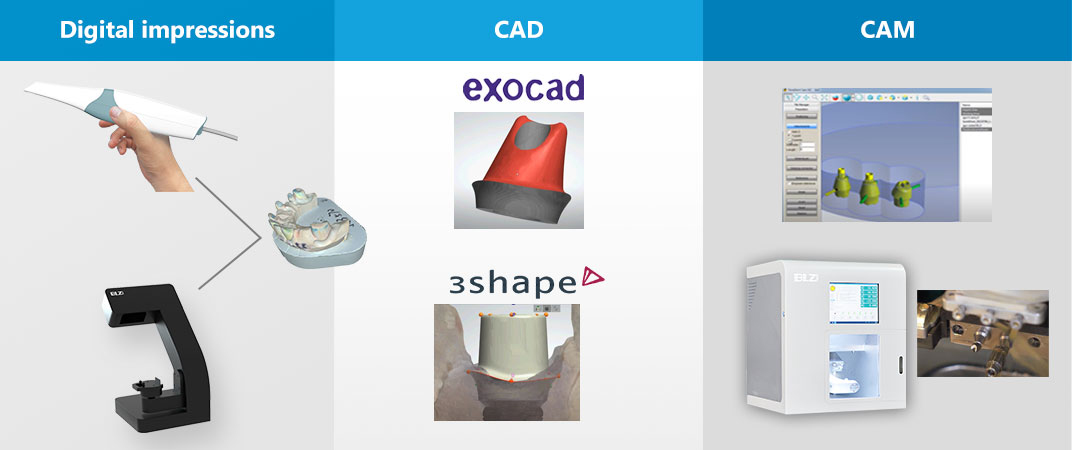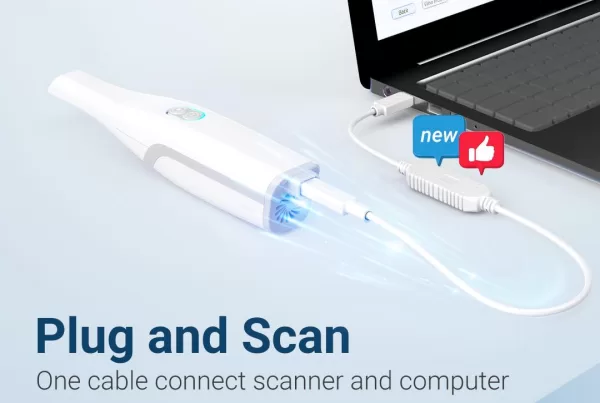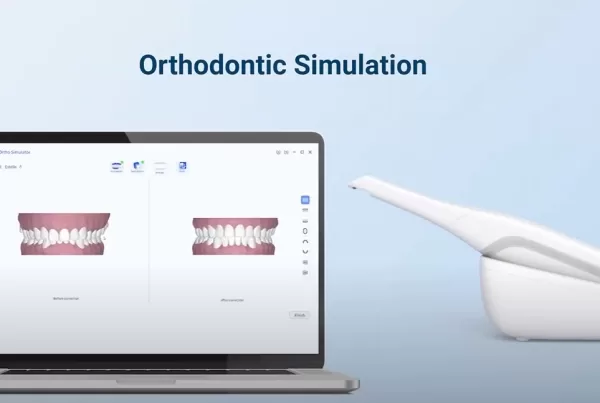
The digital dental laboratory is providing a high-quality product with amazing efficiency to the dentist these days. Are you wondering whether you should go digital with your lab? or what you should know about digital dental? This article will help you know more about the digital dental lab.
Why Your lab shoud go digital?
The answer to this question is easy and clear, but we still need to go through this question shortly. I think there are three main reasons why. For higher efficiency, for better quality, and for a bigger market. Let’s dig in one by one.
Higher efficiency
The main purpose of digital dentistry is to improve the efficiency of the work. It can produce more products in less time than the traditional method. And more product you can deliver means higher satisfaction from the customer, which is what we all pursuit eventually. Besides that, you can design the crown by using the crown database. And it can save a lot of time compared to using wax to build a crown by hand.
Better quality
The digital work has higher accuracy than handwork in general, it’s because the scanner is more accurate than the traditional model. slightly move of the patients during taking the traditional model will affect the accuracy. And the milling machine also has high accuracy.
Bigger market
When digitalizing becomes a trend, it will also change how dentist chooses their partner. The digital dental lab will have an advantage in the market compared to the traditional dental lab.
What’s the digital workflow in dentistry
Dental digital workflow is using CAD/CAM (computer-aided-design and computer-aided-manufacturing) to design and creation of dental restorations, especially dental prostheses, including crowns, crown lays, veneers, inlays, and Onlays, fixed dental prostheses bridges, dental implant-supported restorations, dentures (removable or fixed), and orthodontic appliances.
We will Divide the process into four parts: 1. getting a Digital impression for the start, 2. CAD(Computer-aided design), 3. CAM(computer-aided manufacturing), and 4. post-processing.
1. Digital impressions
Digital impressions captured by an oral scanner or dental lab scanner are the base of digital workflow, all processes and designs are based on the digital model.
2. CAD(Computer-aided design)
CAD is the design phase of designing the crown or bridge or dentures in computer.
3. CAM(computer-aided manufacturing)
CAM stands for computer-assisted design and CAM stands for computer-aided manufacturing.
4. Post-processing
There is still a lot of work we need to do after CAM, like sintering, polishing, and curing cleaning and curing for the 3D printer models.
We will briefly introduce you to the digital workflow for a specific application, as digital dental lab made Zirconia Crown, bridge, Veneers, Inlays and Onlays, digital surgical guide, customized abutment, removable full dentures, and removable Partial dentures.
Zirconia Crown, bridge, Veneers, Inlays, and Onlays

There are two ways to get the digital Digital impressions, by an intraoral scanner and by the dental lab scanner
Surgical Guide

Besides the Digital impressions, the X-ray data is also necessary for digital surgical guide design. The surgical guide needs to be cleaned and curved after being printed by the 3D printer.
Customized abutment

What Should I Consider When Selecting Digital Lab Systems?
We are here to introuduce all machine, software, material you may need to know about digital dentistry.
Dental Scanner
What is a dental scanner?
3D Scanner is a key part of digital dentistry. It can capture dental models or impressions, realizing seamless connection with CAD/CAM system and maximizing your work efficiency. Therefore, it’s the starting point for all dental lab CAD/CAM workflows. It can create a 3D digital model based on the patients’ oral situation or a stone impression.

There are two kinds of scanners, an oral scanner to capture the digital impression of patients, and a lab scanner to get the digital impression of a plaster impression.
Lab scanner
The Lab scanner has a shape like a big box, which also uses a light source to capture dental models or impressions, and the lab scanner is used in a dental lab.
intraoral scanner
The intraoral scanner is a wand-shape device used from capturing a direct optical impression. The scanner projects a light source onto the area to be scanned. The images are captured by imaging sensors and are processed by scanning software, which then produces a 3D surface model in the computer. The intraoral scanner is used in the clinic.
CAD software
There are two main software for dental CAD, which are EXOCAD and 3SHAPE, both are very powerful with many functions, like crown design, inlays/Onlays design, bridge design, denture design, coping design, abutment design, etc…
You can view more in their website:
exocad: https://exocad.com/
3shape: https://www.3shape.com/en/software-overview

CAM machine and material
What is a dental milling machine?
A milling machine is the most well-used machine in CAM, a milling machine can make a crow within 10 minutes. It can highly improve efficiency. A CAD/CAM milling machine is used for the process of milling and grinding three-dimensional objects from a digital file using a computer-guided machine. It can be used to make dental crowns, copings, dental bridges, removable dental prostheses, temporary prostheses, complete dentures, implant abutments, etc. These dental machines work on subtractive processes for milling the desired objects, and are classified as:
Based on axes:
- 4 axis milling machine
- 5 axis milling machine
Based on milling:
- Wet milling machine
- Dry milling machine

What is milling bur?
Milling bur is the Accessory milling machine uses, the milling bur can be considered as the consumable of milling machine. Every bur can only mill 50 to 300 crowns depending on the material of the bur.
Which kind of zirconia blocks I should choose?
Dental CAD-CAM milling machines use different kinds of blocks available in the market, which are made of different materials according to the need of the prostheses.
White zirconia blocks for coping.
Preshaded zirconia blocks for the crown, Veneer, Inlay, Coping, Crown.
3D/multilayers zirconia blocks for the crown, Veneer, Inlay, Coping, Crown.
What can a dental 3D printer do?
Uses of 3D printing include the production of drill guides for dental implants, the production of physical models for prosthodontics, orthodontics, and surgery, the manufacture of dental, craniomaxillofacial, and orthopedic implants, and the fabrication of copings and frameworks for the implant and dental restorations. the 3D printers are classified as LCD printers, DLP printers and use Resin as printing material.


